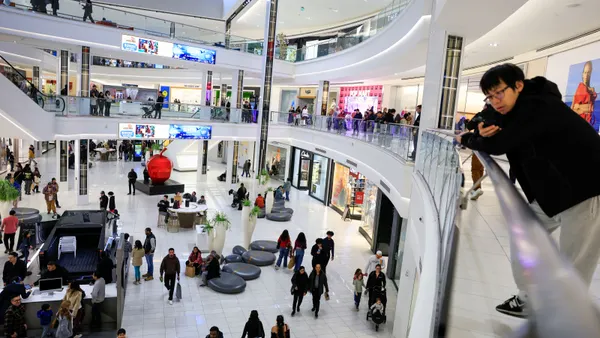Over the years, Black Friday (the day itself as well as the surrounding promotional days or even weeks) has become one of retail's premier battlegrounds, especially between big-box retailers and mass merchants like Amazon, Walmart, Target and Best Buy. Year after year, these four companies can't take the competitive loss of not opening their doors on Thanksgiving day (a trend that is slowing especially among specialty players) and Black Friday.
Last year, the retail industry raked in a record $5.03 billion just online by the end of the day on Black Friday, a 16.9% increase over the year prior.
In the lead up to the impending holiday, it's helpful to look at years past to see where the season is headed, and who's leading the way. Using data compiled and analyzed by Earnest Research, a research firm that generates consumer insights based off credit and debit card transactions, Retail Dive looked at how market share is shifting in-store and online among those four big players, as well as who's leading the way in the department store sector.
Here's three charts that show how Black Friday is evolving over time, and who's plowing the path ahead.
-
Amazon is cutting into Walmart's market share
Amazon's rise is a familiar narrative in retail, especially on Black Friday as it expands into an increasingly digital shopping holiday. In-store Black Friday shopping was once considered a fun family activity where people would gather outside stores in the wee hours of the morning waiting for their chance at special discounts on big-ticket items like TVs and grills. Many people still follow this tradition; however, more and more are turning to the convenience of online shopping, which last year led some analysts to begin referring to the holiday as, "couch Friday."
For the first year, Amazon pulled ahead of Walmart's share for consumer spend, when comparing online and brick-and-mortar transactions at those two retailers as well as Target and Best Buy over the two weeks following Black Friday, according to Earnest Research. Part of that is likely thanks to an elaborate marketing strategy deployed by Amazon last year which began promoting holiday deals 50 days before the actual shopping event. And as Amazon attracts more users into its sticky Prime ecosystem and fast delivery standards, it's taking away shoppers from rivals Walmart and Target.
"When you look at merchants adding customers, generally as a rule of thumb the first customers are your most loyal, most productive, early adopters of everything. As you add new customers, each one is less valuable," Andrew Robson, president and chief revenue officer of Earnest Research, told Retail Dive in an interview. "But for Amazon, Wayfair and other e-commerce brands, it's the opposite. Each new customer cohort is spending more and offering more value to the company."
-
Walmart's digital growth still pales in comparison to Amazon's
Since the acquisition of Jet.com and acqui-hire of its founder Marc Lore, Walmart has overhauled digital operations and prioritized services like order pickup as well as same-day and next-day delivery. In April, the company revealed a sleek new e-commerce website and it continues to buy up digitally native and specialty brands. But many of these efforts are still maturing, and reaching parity with Amazon's online market dominance is nowhere near in sight.
Last year, Amazon grabbed 83% of digital sales during the two weeks after Black Friday, when compared to Walmart (7.9%), Best Buy (5.8%) and Target (3.3%). Amazon's plan last year centered in part around more promotions linked to its Alexa smart assistant and the company's launch of a "Watch a Deal" app. This year, the industry should be ready for Amazon to continue to push the envelope online.
-
Kohl's is rising as Macy's stumbles
There's no doubt that Kohl's was a big winner of holiday 2017. Among department store retailers, Kohl's grabbed the second biggest slice of market share, 26.6%, following Macy's at 30.3%. That represented a bump for Kohl's, but a slight drop for Macy's. Both department stores have been reinventing themselves for a new era of consumer shopping habits. For Kohl's, that's meant taking big risks, or what some have referred to as making a deal with the devil: Amazon. Last September, the company announced a partnership in which customers could make Amazon returns at its stores and it's since doubled down on that idea.
For department stores, the in-store experience, differentiated merchandise and promotions are all especially important to winning on Black Friday. And those who are rising are making strides to meet the table stakes delivery demands and taking risks that will set them apart.













